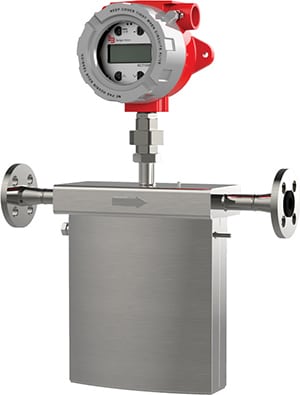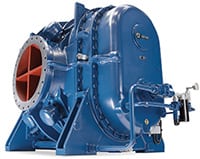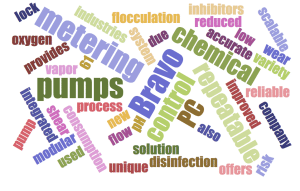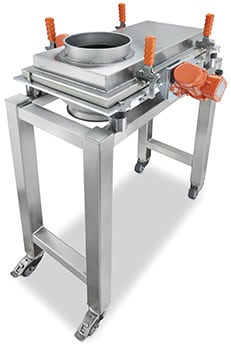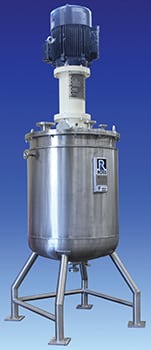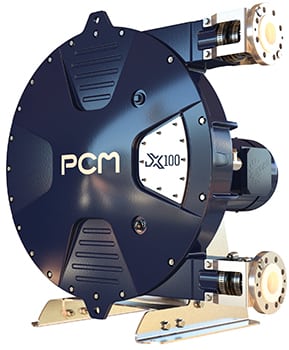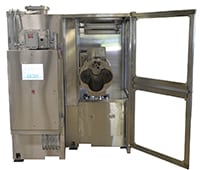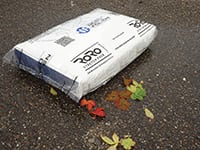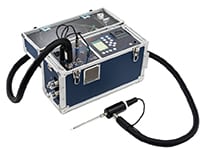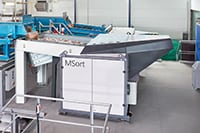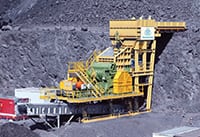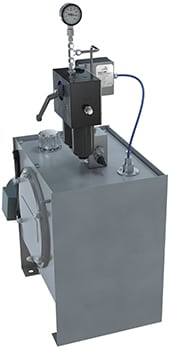New Products & Services
November 2017
The Coriolis RCT1000 line of mass flowmeters (photo) was recently enhanced with the addition of an explosion-proof transmitter with intrinsically safe sensors. The hazardous-location certification opens up an array of new applications for RCT1000 flowmeters, including chemical and petrochemical processing, oil exploration and refining, and a wide variety of industrial processing applications in potentially hazardous environments. The RCT1000 mass flowmeter identifies flowrate by directly measuring fluid mass over a wide range of temperatures with a high degree of accuracy. For fluids consisting of two liquids or a liquid with suspended solids, this system can derive the concentration and mass of each fluid based on the density measurement. The unobstructed, open-flow design makes it suitable for a variety of fluids, such as slurries and other viscous, nonconductive fluids. Booth 1203 — Badger Meter, Inc., Milwaukee, Wis.
This company now offers a wider range of process air stages by introducing the large blower series known as Alpha Blower (photo). Featuring 104 model variants, this series provides a high degree of flexibility for numerous applications. These positive-displacement blowers reach volume flows from 9,000 to 77,000 m³/h at a maximum overpressure of 1,000 mbar and a maximum negative pressure of –800 mbar. The blowers are suitable for the production of gases and oxygen. or in the cement, foodstuff and chemical industry for pneumatic conveyance of bulk material. — Aerzener Maschinenfabrik GmbH, Aerzen, Germany
Launched last month at Weftec (Chicago; October 2–4), the new Bravo chemical metering system provides improved process control with reliable, accurate and repeatable flow, and reduced chemical consumption, says the company. Bravo is an integrated, modular and scalable solution used in a variety of industries for disinfection, pH control, flocculation, corrosion inhibitors, oxygen scavengers and containment elimination. Bravo incorporates NSF/ANSI 61 certified progressive-cavity (PC) metering pumps. The unique design of a PC pump offers several advantages compared to traditional chemical-metering pumps due to pumping characteristics that allow for consistent, precise, repeatable metering with low shear, minimal pulsations and no vapor lock. These pumps also wear predictably, so there is no risk for catastrophic failure. — Seepex Inc., Enon, Ohio
The Contromat VE 450 (photo) and VE 630 (which is square shaped) handle sifting capacities between 0.15 and 0.3 m². Previously, the Contromat had been delivered without an outlet for foreign particles, which remained on the sieve and had to be removed manually or by means of a suction nozzle. Now, the new Contromat version is rectangular, and has an outlet for oversized and foreign particles. It prevents unwanted agglomerates from remaining in the final product. All product-wetted parts are mainly stainless steel (1.4301). Cleaning and replacing the sieve decks is extremely simple, since the Contromat can be dismounted without tools. The control sifter is also available in an optional ATEX version. — Fuchs Maschinen AG, Granges-Paccot, Switzerland
These lidded drums (photo) are dull TIG (tungsten-inert gas) welded with welding filler material and without gaps. The seams are rolled flat and finely polished inside and out. The drums are also easy to clean and residue-free, and have a high stability, even at maximum load. They are available in volumes from 0.5 to 300 L, and in different diameters. The surfaces are polished or electro-polished for optimum product output with roughness less than 0.25 μm. Sealing materials include silicone, EPDM, Viton, and FEP-coated (fluorinated ethylene propylene) seals with FDA approval. In addition to the industry-standard materials, the company now also offers drums for extreme conditions in Hastelloy 2.4602/C 22 nickel alloy, which is highly corrosion resistant to acids and chlorine dioxide. — Bolz Intec GmbH, Argenbühl-Eisenharz, Germany
This company has fabricated a 300-gal vessel (photo) designed for 5 psi internal pressure at 300°F. All of the wetted surfaces are stainless-steel type 304L polished to 240-grit finish. The vessel is agitated by a special disperser blade driven to 1,150 rpm by a 75-h.p. explosion-proof motor. The agitator shaft utilizes a mechanical seal running in an oil bath. A 50-psig ASME Code-stamped baffled jacket surrounds the sides and vessel bottom for heating and cooling. All elastomers, nozzles, sensors, dip tubes, valves and operator controls are supplied based on the end user’s specific requirements. Numerous other custom-engineered options are available on fabricated pressure vessels, including jacketing, agitation, pressurization, sanitary requirements and more. — Charles Ross and Son Co., Hauppauge, N.Y.
The new Delasco DX series (photo) is a peristaltic pump that minimizes water waste while increasing pumping efficiency. The Delasco DX series consists of three diverse models (DX65, DX80 and DX100) that are equipped with a technology to meet the expectations of mining and environmental applications, as well as the requirements of the chemical manufacturing and renewable energies sectors. The main concerns of users when dealing with large peristaltic pumps are to improve the efficiency and cost-effectiveness of their operations, enhance maintenance with MIP (maintenance in place) and reduce energy consumption. The pump is suitable for all fluid flows — abrasive and high-solids-content slurries (up to 80% dry solids), corrosive high-density media, viscous shear-sensitive particles or corrosive gaseous fluids. There is no need to add water to enable pumping, nor is the pump operation or efficiency affected by variations in solids content, viscosity or pressure. The internal bearing allows DX series pumps to run with any type of drive and motor thanks to a quick plug-in drive system. The DX series can generate flowrates up to 55 m3/h and is also available in duplex configuration. — PCM Europe S.A.S., Levallois-Perret, France
The E8815 stainless-steel, large-batch explosion-proof blender (photo) is manufactured to Class I, Div. I, Groups C & D explosion-proof electrical rating. ATEX ratings and non-explosion-proof models are also available. These blenders are designed for pharmaceutical and chemical-blending applications. Additional options include the following: jacketed containers available for use with refrigerated or heated circulators; temperature sensors; thermal camera; and several standard blending assemblies. E8815 blender models range from 10 to 25 gal in volume, with stainless-steel exteriors and standard powder-coat finish available. Servo-controlled blending-container auto lift and pour functionality makes large-batch processing easier to control and integrate. — Eberbach Corp., Ann Arbor, Mich.
The CoriMix continuous-ring layer mixer (photo) a features a ring layer system that rotates with circumferential speeds of up to 40 m/s. As a result, the product components are accelerated through centrifugal force. This causes a ring layer to be formed. Within this concentric layer there are enormous differences in speed between the rapidly rotating mixing tools and the stationary container wall. As a consequence, friction is particularly high in the ring layer profile. The specially shaped tools of the mixing unit move the product during the subsequent process in a pattern similar to plug flow through the mixing chamber. Because this happens very rapidly, the residence times are very short and the residence time deviation is narrow. Depending on the product, throughput of up to 0.50 m3/h in a laboratory setting and up to 500 m3/h in production can be achieved, with an effective volume of between 5 and 3,000 L. — Gebr. Lödige Maschinenbau GmbH, Paderborn, Germany
The new bag-in-bag system quickly and reliably packs filled paper bags individually or in groups with a weather-resistant plastic film (photo). This protects the contents against moisture, dust, insects and other environmental influences during storage and transport. The bag-in-bag is easy to integrate into existing filling and packaging systems. The impermeable film keeps dust from escaping from the filled bags, and it prevents product losses. The films have thicknesses of 30 to 100µm, so material costs are low. The outer packaging in the paper bags does not require an intermediate layer made of polyethylene (PE), a fact that also cuts costs and increases filling performance, says the company. The highly efficient system is so reliable that ultrasonic welding of the bags is usually not necessary. The bag-in-bag is designed for inline packers with a capacity of up to 800 bags per hour. — Beumer Group GmbH & Co. KG, Beckum, Germany
The E9000 emissions analyzer (photo) features a heated sample line and is suitable for regulatory and maintenance use in boiler, burner, engine, turbine, furnace and other combustion applications. The analyzer can accommodate up to nine total gas sensors, including electrochemical sensors for O2, CO, NO, NO2, SO2 or H2S, or NDIR sensors for CO2, CxHy (HC) or high CO. An internal thermoelectric chiller provides automatic condensate removal. The device’s internal data storage has memory to conduct up to 16,000 tests, and the onboard software automatically logs data. — E Instruments International LLC, Langhorne, Pa.
Materials with the same visual appearance can now be precisely, quickly and cost-effectively sorted with the new MSort NIR (photo), which uses near-infrared (NIR) spectroscopy to physically analyze the material. At the beginning of the sorting process, the material flow passes by an NIR camera through a chute in free-fall. The camera allows the individual particles to be uniquely identified and the images to then be analyzed. Software analyzes the images and determines, in fractions of a second, whether a particle needs to be sorted out. The bulk material then passes by a strip of compressed-air nozzles, and the rejected particles are blown out. The sorting precision is said to be at least 95% in one sorting step. The MSort NIR type AP sorts bulk materials in the grain range of 10–50 mm with a throughput of up to 40 ton/h. This machine is especially suitable for separating plastics in glass recycling processes. — Allgaier Werke GmbH, Uhingen, Germany
In addition to the requirement that neither flames nor pressure escape from the protection system, flameless venting devices should also be evaluated in terms of their venting efficiency and weight. The new Q-Ball flameless venting device (photo), which is primarily designed for elevators and screens, uses the principle of parallel contour relief developed by Roland Bunse. Thanks to this unique design, the weight of the Q-Ball is very low. While comparable products weigh around 45 kg, the Q-Ball only weighs around 25 kg, and is 3 kg lighter than the company's similar Q-Box product. — Rembe GmbH Safety + Control, Brilon, Germany
The new ERC25-25 eccentric roll crusher (photo) can process hard rock and ores efficiently and economically in underground mining operations. It features a compact design and an integrated screen that is 20 to 50% lower than conventional primary crushers, a feature that greatly simplifies transportation, installation and maintenance below ground, says the company. The patented design features a roll mounted eccentrically between the crushing and the screening chambers, which offers greater efficiency and productivity compared with other crusher types. The large, constant stroke of the ERC25-25 crusher combines with the integrated screen to provide very high crushing intensity and throughputs of up to 3,000 ton/h. — thyssenkrupp Industrial Solutions AG, Essen, Germany
thyssenkrupp-industrial-solutions.com
In addition to large amounts of conventional dust, the new IVS 100 range of industrial vacuums (photo) also pick up hazardous, as well as combustible dust and coarse particles. The particles are vacuumed directly where they are generated and therefore cannot spread into the production environment. In mobile use, these vacuum cleaners are ideal for deep and maintenance cleaning in workshops, production halls, silos, logistics centers or builder's yards. In stationary operation, they can be integrated in processing, finishing or pouring processes and in this way offer maximum flexibility in use. For the first time, vacuums in this class offer the option of remote control. With a range of up to 30 m, these vacuum cleaners can be started and stopped directly at the suction point without the operator having to move from the spot. — Alfred Kärcher GmbH & Co. KG, Winnenden, Germany
The XperLUBE system (photo) uses automotive-style solenoid injectors to deliver lubricant in precise quantities. Unlike traditional lubrication devices, XperLUBE integrates fully with modern control systems and adapts to changes in operating conditions. A key feature is the way each injector records the precise volume of oil delivered at every stroke. This measured lube rate is used as a feedback signal to ensure that the actual lube rate always matches the target value. Standardized, modular design makes XperLUBE easy to retrofit to existing compressors. Users can start with a simple standalone installation or opt for a more powerful system linked to the plant’s distributed control system (DCS) if necessary. — Hoerbiger Ventilwerke GmbH & Co. KG, Vienna, Austria
